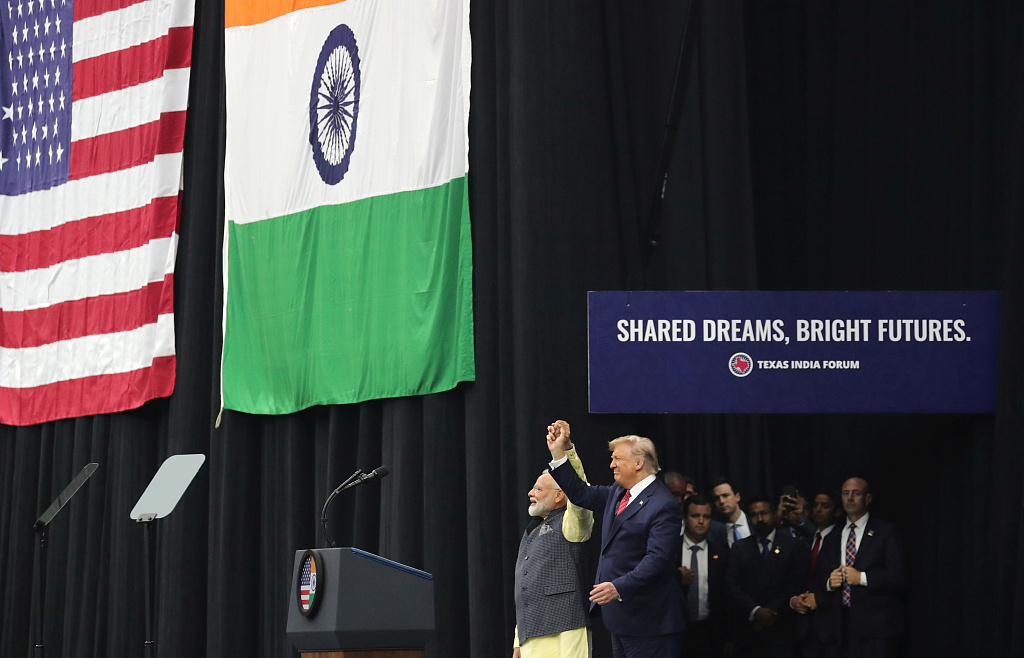Editor's note: Tom Fowdy graduated from Oxford University's China Studies Program and majored in politics at Durham University and writes about international relations focusing on China and the Democratic People's Republic of Korea. The article reflects the author's opinions, and not necessarily the views of CGTN.
President Donald Trump and India Prime Minister Narendra Modi attended a mass rally in Texas on Sunday, as part of the prime minister's re-election campaign: "Howdy, Modi!." Described as the first ever mass rally dedicated to a foreign leader visiting the United States, Trump introduce Modi as one of "America's greatest, most devoted and most loyal friends," with the prime minister in turn lavishing praise upon the president as a "true friend" of India, praising him as "energetic" and "full of wit."
The rally represents a crucial and decisive turning point in India's foreign policy. While the event is symbolic, it creates a definitive "public memory" which sets out a new paradigm. New Delhi's traditional stance of non-alignment and neutrality which emerged after the country's independence is fading.
In its place is an increasingly strategic and unofficial alliance with the United States, aimed at stifling China at a regional level. This means that relations ahead between the two may become frosty.
While facts will always be facts, we fundamentally remember and interpret history through the imagery and symbolism which defines it and tells a "story." When Richard Nixon met Mao Zedong in 1974, the event was shocking and surprising to Americans at the time, yet its momentum and the subsequent memory of that meeting would eventually stand as a milestone marking a new era between the two countries. Another searing image is when Deng Xiaoping was photographed wearing a cowboy hat. In politics, symbolism can ultimately drive substance.
The scene of Donald Trump and Narendra Modi together in a mass rally in Texas might well be setting a definitive moment in the history of India-U.S. ties. Traditionally, New Delhi has been carefully neutral, proclaiming a foreign policy of official no-alignment, avoiding the cold war power blocs. In doing so, it maintained a balance between Washington and Beijing. Although it had several disagreements with the latter, it nevertheless opted for stability in its relationship with China and focused on economics.
However, things may be changing. One cannot say that it wasn't coming. Firstly, Modi's rule at home is becoming increasingly assertive, nationalist, and hard-line. By getting support from the U.S., he knows Washington will selectively ignore these issues in favor of its regional objectives. But tied to that, and more obviously, the U.S. has long been trying to court New Delhi under the mantra of the "Indo-Pacific."

U.S. President Donald Trump and India's Prime Minister Narendra Modi participate in the "Howdy Modi" event in Houston, Texas, U.S., September 22, 2019. /VCG Photo
U.S. President Donald Trump and India's Prime Minister Narendra Modi participate in the "Howdy Modi" event in Houston, Texas, U.S., September 22, 2019. /VCG Photo
Since last year, the two countries have signed an intelligence sharing agreement and engaged in broader military and naval cooperation. On the economic front, Modi has increased efforts in blocking the Regional Comprehensive Economic Partnership (RCEP), a trade agreement which involves China, while pushing a Indo-American trade deal. He also refused to endorse the Belt and Road Initiative, while openly hailing America as a "loyal friend" and piling praise on Trump at a rally orchestrated for him.
In this sense, a U.S.-India axis is now emerging and it has had its "definitive moment." The question is how China will respond to this. While it is unlikely things will descend into outright hostility or confrontation, Beijing must be prepared for the emergence of an increasingly unfriendly strategic neighbor.
First, China should seek to pursue the RCEP without India; it is obvious New Delhi's disruption of the nearly finalized agreement on protectionist grounds is a strategic nod to the United States.
Next, China should consolidate its diplomacy and investment in upholding good ties with India's neighbors, including Pakistan, Bangladesh, Nepal, The Maldives, Sri Lanka and Afghanistan.
Third, and most importantly, Beijing should avoid being put into a nationalist trap of confrontation by New Delhi itself. Clashes and confrontations should be avoided, because they will only serve to empower Delhi's tilt towards Washington. The door should be ultimately kept open to India on a diplomatic level, and Beijing must work hard to convince the country that the relationship is beneficial.
As a whole, we witnessed at the rally the emergence of a new strategic reality with the United States and India coming closer than any point in history. This Modi-Trump rally may offer little in substance, but has deep political and diplomatic connotations through the sheer strength of its symbolism, of which China must respond to mindfully, but cautiously.
(If you want to contribute and have specific expertise, please contact us at opinions@cgtn.com.)